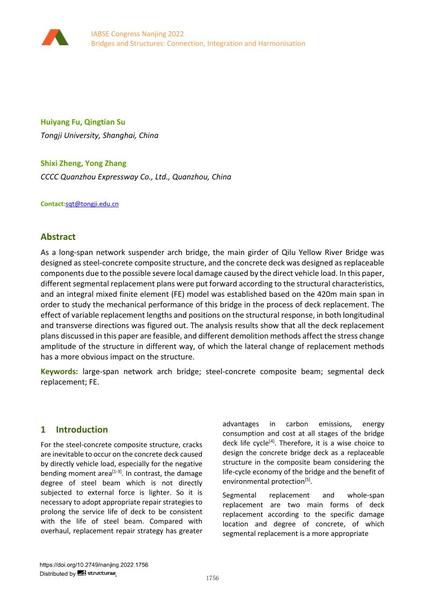Analysis on Segmental Deck Replacement Plan for Large-Span Network Arch Bridge

|
|
|||||||||||
Détails bibliographiques
| Auteur(s): |
Huiyang Fu
(Tongji University, Shanghai, China)
Qingtian Su (Tongji University, Shanghai, China) Shixi Zheng (CCCC Quanzhou Expressway Co., Ltd., Quanzhou, China) Yong Zhang (CCCC Quanzhou Expressway Co., Ltd., Quanzhou, China) |
||||
|---|---|---|---|---|---|
| Médium: | papier de conférence | ||||
| Langue(s): | anglais | ||||
| Conférence: | IABSE Congress: Bridges and Structures: Connection, Integration and Harmonisation, Nanjing, People's Republic of China, 21-23 September 2022 | ||||
| Publié dans: | IABSE Congress Nanjing 2022 | ||||
|
|||||
| Page(s): | 1756-1764 | ||||
| Nombre total de pages (du PDF): | 9 | ||||
| DOI: | 10.2749/nanjing.2022.1756 | ||||
| Abstrait: |
As a long-span network suspender arch bridge, the main girder of Qilu Yellow River Bridge was designed as steel-concrete composite structure, and the concrete deck was designed as replaceable components due to the possible severe local damage caused by the direct vehicle load. In this paper, different segmental replacement plans were put forward according to the structural characteristics, and an integral mixed finite element (FE) model was established based on the 420m main span in order to study the mechanical performance of this bridge in the process of deck replacement. The effect of variable replacement lengths and positions on the structural response, in both longitudinal and transverse directions was figured out. The analysis results show that all the deck replacement plans discussed in this paper are feasible, and different demolition methods affect the stress change amplitude of the structure in different way, of which the lateral change of replacement methods has a more obvious impact on the structure. |
||||
| Copyright: | © 2022 International Association for Bridge and Structural Engineering (IABSE) | ||||
| License: | Cette oeuvre ne peut être utilisée sans la permission de l'auteur ou détenteur des droits. |
||||
